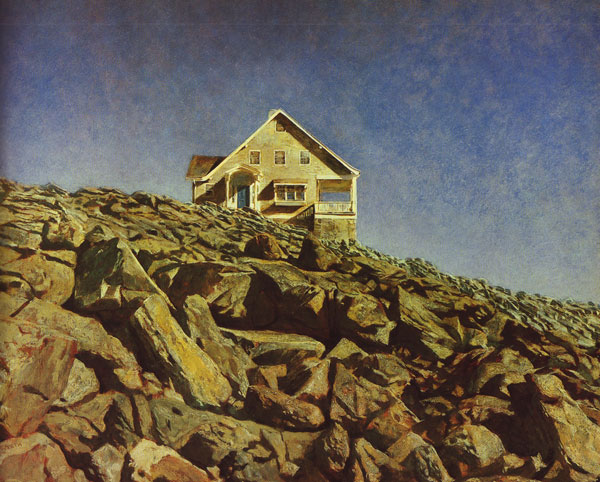

| Kent House |
Jamie Wyeth |
| Brandywine River Museum |
Oil |
The Kent House It is said that a thing can be defined by it’s environment. Rockwell Kent’s house on Monhegan Island certainly proves this observation. It does so by withstanding nearly one hundred years of harsh New England winters and everything that a fierce sea can throw at it. With his own hands, Rockwell Kent designed and built the little house for his mother. He anchored it onto Monhegan’s shattered rocks just above the high tide line and it has endured to become the summer home and studio of Jamie Wyeth. In 1905, Rockwell Kent arrived on Monhegan, Maine, a small secluded island that sits ten miles south of Port Clyde and the mainland. There he unexpectedly found more than a destination for his art; he discovered a way of life. Kent envied the inhabitants for their hard work ethic and the power it took to pull food from the sea. He was, in his words,” ashamed of his thin wrists and artists hands and for the first time I saw my work in true perspective and felt it’s triviality.” And it came to be that Rockwell Kent went on to stay on Monhegan finding work as a laborer by digging wells, harvesting the sea’s wealth and by designing and building houses. This inspired many paintings and heightened his sense of the importance of meaningful work and social justice for the common man. His persistent criticism of the political establishment kept him at odds with mainstream America and permanently affixed his name with the advocacy of Communism. He was blackballed by the American government and hailed by the Soviet government in it’s anti American propaganda campaign. He not only suffered financially because of his politics, but many believe that his art suffered as he tried to incorporate Social Realism into his work. Kent left Monhegan Island and Jamie believes that upon doing so, he lost his reason to paint. Subsequently he became embroiled in the McCarthy witch hunt of the 1950’s. Jamie Wyeth created his painting of this fine structure, aptly named, “The Kent House”, because he says he wanted to make a portrait of the house before the sea claimed it. During the execution of the painting, Jamie constructed a platform and attached the structure to the sharp boulders at the ocean’s edge. There he placed his easel everyday and worked on the portrait. For this interview he recounted a memorable story about one of those fierce New England storms. While howling winds and crashing waves battered the house, he wondered how his platform had withstood the punishment. Donning rubber hip boots he left the house in the middle of the night and made his way down onto the rocks to the location of the platform. Indeed it had been destroyed and washed away. At the time of this realization Jamie heard a loud “BOOM!” and saw a huge white wall of water that knocked him off of his feet. As the water receded it filled his rubber hip boots and pulled each leg with the power of ten men. What went through his mind at this time was the warning that the locals had always told him. To “swim out” if you ever get washed over the rocks. This is because the pounding surf would pulverize a person and they have a better chance to swim away from the island. Fortunately, he was able to maintain his grasp of the boulders and regain his footing, only loosing his flashlight in the process. At first, when viewing the painting, one can imagine the striking resemblance to a Greek temple perched atop shattered rocks overlooking the Mediterranean. It seems to be more about a building than about geometric shapes. However, on closer inspection, the abstract quality and strong geometric composition, Jamie’s portrait lends itself to his belief that a painting should be interesting on it’s sides or even upside down and should be able to retain interesting shapes and forms no matter the perspective. In fact, Jamie says he prefers abstract painting because it is much more exciting and he admits that a lot of his work is not detailed. Indeed it is fascinating to look at Jamie’s work and see how he strives for abstract composition relative to it’s use in realist painting. One can forever discuss and dissect a work of art by analyzing it’s purpose and message. Either evaluating it’s technique or strategies of the artist. But only Jamie Wyeth knows why he sat down in 1971 and began this wonderful picture. As he said during our interview, “painting is to me a combination of observations.” The bottom line is that art is subjective. Evoking a response is highly personal and varies greatly from person to person. This can be summed up in a story Jamie told to us. When the painting had first been exhibited, he walked quietly around the gallery and eavesdropped on a couple who had stopped to view his new painting. As their eyes searched the vast sky and focused on the house sitting on it’s rocky stage, Jamie expected to hear something very insightful. Instead, the man turned to his wife and said “sure beats mowing the grass!” |
|
"Kent House" Copyright © Jamie Wyeth |
|

The text, photos & artwork used in this web site are protected under U.S. Copyright Law and may not be used in any form, in whole or in part, without express written permission of Mark Dance.